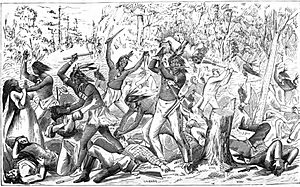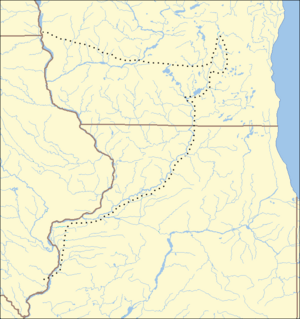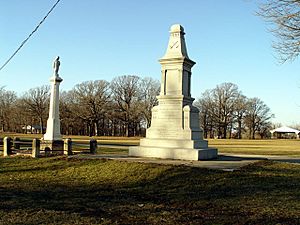Indian Creek massacre facts for kids
Quick facts for kids Indian Creek Massacre |
|||||
|---|---|---|---|---|---|
| Part of the Black Hawk War | |||||
 An 1878 depiction of the massacre |
|||||
|
|||||
| Belligerents | |||||
| Illinois settlers | Potawatomi raiding party and three Sauks | ||||
| Strength | |||||
| 23 civilians | 40–80 warriors | ||||
| Casualties and losses | |||||
| 15 killed, 2 captured | |||||
The Indian Creek Massacre happened on May 21, 1832. It was an attack by a group of Native Americans on settlers in LaSalle County, Illinois. This event took place during the Black Hawk War. However, it was not directly ordered by the Sauk leader Black Hawk.
The attack followed a disagreement about a dam built by a settler. This dam stopped fish from reaching a nearby Potawatomi village. The settlers refused to remove the dam. Between 40 and 80 Potawatomi warriors, along with three Sauks, attacked. They killed fifteen settlers, including women and children. Two young women were taken by the attackers. They were later returned safely after about two weeks.
This event, and the wider war, made settlers seek safety. Many went to frontier forts protected by the militia. Later, three men were arrested for the killings. But the charges were dropped because witnesses could not confirm their involvement. Today, memorials mark the massacre site. They are located in Shabbona County Park in LaSalle County. This is about 14 miles (23 km) north of Ottawa, Illinois.
Contents
Why the Indian Creek Attack Happened
The Indian Creek massacre began with a disagreement. It was between U.S. settlers and a Potawatomi Native American village. This village was located along the Indian Creek in LaSalle County, Illinois.
In the spring of 1832, a blacksmith named William Davis built a dam. He wanted to use the creek's power for his sawmill. Meau-eus, the main chief of the Potawatomi village, complained to Davis. He said the dam stopped fish from reaching their village. Davis ignored these complaints. He even attacked a Potawatomi man who tried to take down the dam.
The villagers wanted to get even. But Potawatomi chiefs Shabbona and Waubonsie suggested a different idea. They advised the villagers to fish below the dam instead.
Meanwhile, in February 1832, a Sauk leader named Black Hawk wanted to return to his people's old lands. These lands had been given to the United States in a treaty. Black Hawk hoped that the Potawatomi in Illinois would help him. He thought they also had problems with the United States expanding into Native American lands.
Potawatomi leaders were worried. They believed the United States was too strong to fight. They told their people to stay neutral in the upcoming conflict. However, chiefs in Native American tribes did not always have the power to make everyone obey. Potawatomi leaders feared their whole tribe would be punished if any of them supported Black Hawk.
In mid-May, Potawatomi leaders told Black Hawk they would not support him. Black Hawk then led a group of Sauks, Meskwakis, and Kickapoos. This group was known as the "British Band". They crossed the Mississippi River from Iowa into Illinois. Black Hawk's exact reasons were unclear, but he seemed to want to avoid fighting.
The Coming Conflict
| Map of Black Hawk War sites Symbols are wikilinked to article |
The Black Hawk War officially began on May 14, 1832. Black Hawk's warriors strongly defeated Illinois militiamen at the Battle of Stillman's Run. Potawatomi Chief Shabbona became concerned. He worried that Black Hawk's success might lead to more Native attacks on American settlements. He also feared that Potawatomis would be blamed.
Soon after the battle, Shabbona, his son, and his nephew rode out. They wanted to warn nearby American settlers about the danger. Many people quickly fled to Ottawa for safety. But William Davis, the settler who built the dam, convinced some neighbors to stay. He told them they were not in danger.
Twenty-three people remained at the Davis settlement. This group included the Davis family, the Hall family, the Pettigrew family, and several other men.
The Attack on Indian Creek
On the afternoon of May 21, 1832, a group approached the Davis cabin. This group included about forty to eighty Potawatomi warriors. Three Sauks from Black Hawk's band were also with them. They quickly climbed over the fence and rushed to attack.
Several male settlers were working in the fields or in the blacksmith's shop. They hurried to the house during the attack. Many of them were killed. Six young men managed to escape the attack by running away. In total, fifteen settlers lost their lives.
Historians today do not agree on who led this attack. Some believe it was led by the Potawatomi man Davis had assaulted at the dam. Others suggest different Potawatomi warriors were in charge.
After the Massacre
The Indian Creek massacre was a very important event during the Black Hawk War. It caused great fear among the settlers. Many people left their homes and sought safety. They went to frontier forts, like Fort Dearborn in Chicago.
On May 21 or 22, people in Chicago sent out a group of militia scouts. They wanted to find out what was happening between Chicago and Ottawa. This group, led by Captain Jesse B. Brown, found the bodies of the 15 victims at Indian Creek on May 22. They buried the dead and then went to Ottawa. There, they reported what they had found. Because of this event, the Illinois militia was able to get more recruits from Illinois and Kentucky.
After the war, three men were charged in connection with the Indian Creek killings. Warrants were issued for them at the LaSalle County Courthouse. However, the charges were later dropped. The Hall sisters, who had been captured and released, could not identify the three men as part of the attacking group.
In 1833, the Illinois General Assembly passed a law. It gave each of the Hall sisters 80 acres (320,000 m2) of land. This land was along the Illinois and Michigan Canal. It was given as a way to help them and recognize what they had gone through.
In 1877, William Munson, who married Rachel Hall, built a monument. It marked where the victims of the massacre were buried. This monument, located 14 miles (23 km) north of Ottawa, Illinois, cost $700.
In 1902, the area was named Shabbona Park. The Illinois legislature set aside $5,000 for a new monument and its upkeep. On August 29, 1906, a 16-foot (4.9 m) granite monument was dedicated. Four thousand people attended the ceremony. Shabbona County Park is in northern LaSalle County, west of Illinois Route 23. It should not be confused with Shabbona Lake State Park in DeKalb County.
Images for kids





